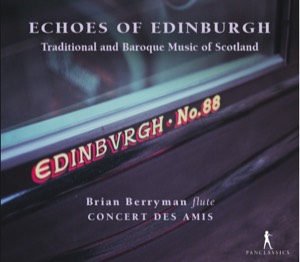
"Stupendous virtuosity!" -- Kieler Nachrichten
About me
Just a few words about where I came from and where I'm headed...
Brian was raised in the small town of Liverpool, Nova Scotia, on Canada's east coast; he has lived and worked in Germany for over twenty years. He was born into a musical family: his mother was a music teacher and organist, his father was an enthusiastic amateur choral singer.
After humble beginnings, joining the the band at the local paper mill at age twelve, he has become one of the most sought after specialists on historical flutes in the current early music scene in Germany.
After completing his Bachelor of Music in Flute Performance at the University of Victoria, Canada and a Master's and Doctor of Musical Arts in Performance Practice at Stanford University in California, he studied baroque flute with Wilbert Hazelzet at the Royal Conservatory in The Hague, Netherlands, completing the "Certificaat Oude Muziek".
Brian appears throughout Europe and on numerous radio and CD recordings with such notable ensembles as The Amsterdam Baroque Orchestra, Barockorchester Stuttgart, Concerto Köln and the FestspielOrchesterGöttingen (FOG) of the International Handel Festival Göttingen founded by Nicolas McGegan, then led by Laurence Cummings and now by Georges Petrou.

With his ensemble La Ricordanza, of whom he is a founding member, he has recorded 5 critically acclaimed CDs. His solo recording, "Crossing the Border", and the concert programme of the same name, are a must-see for aficionados of stylistically adventurous and creative flute playing. His solo CD, "Almost Home", explores his Nova Scotian roots: Together with guitarist Cornelius Bode he presents a programme of traditional Irish and Scottish music, as well as music from Cape Breton on Canada's east coast. In his newest CD "Echoes of Edinburgh" the fusion of baroque and traditional styles goes deeper, with baroque strings and harpsichord teaming up with guitar and bodhrán to explore the roots of Scottish 18th century music.
Since 2006 he is principal flute of the period-instrument orchestra The Hannoversche Hofkapelle and can be heard as soloist regularly in their annual (and sold out!) New Year's Eve concert. Brian was a faculty member of the music school in Salzgitter, Germany for over ten years, teaching flute and conducting the youth orchestra, with whom he has won numerous prizes.
12 October 2025
Sankt Michaeliskirche, Eutin
J.S. Bach - Missa h-moll
7 November 2025
Laeiszhalle, Hamburg
W.A. Mozart: Kyrie d-Moll (KV 341), Symphony no.40 g-Moll, Requiem d-Moll
8 November 2025
St. Severi, Otterndorf
W.A. Mozart: Kyrie d-Moll (KV 341), Symphony no.40 g-Moll, Requiem d-Moll
15 November 2025
St. Martinskirche, Hannover-Linden
J.S. Bach - Missa h-moll
16 November 2025
Pauluskirche, Hannover
J.S. Bach - Missa h-moll
29 November 2025
Markuskirche, Hannover
J.S. Bach - Magnificat
4 December 2025
Engerkirche, Zürich (CH)
J.S. Bach - Magnificat
7 December 2025
Stadtkirche Celle
J.S. Bach - Weihnachtsoratorium
12 December 2025
Mariendom, Hamburg
J.S. Bach - Weihnachtsoratorium
14 December 2025
Johanniskirche, Göttingen
J.S. Bach - Weihnachtsoratorium
20 December 2025
Marktkirche Hannover
J.S. Bach - Weihnachtsoratorium
21 December 2025
Marktkirche Hannover
J.S. Bach - Weihnachtsoratorium
26 December 2025
Trinitatiskirche, Wolfenbüttel
J.S. Bach - Weihnachtsoratorium
31 December 2025
Schloss Herrenhausen, Hannover
New Year's Eve Concert, 30 Years of the Hannoversche Hofkapelle!
incl. J.S. Bach - Suite in B Minor
15 March 2026
Stadtkirche Celle
J.S. Bach - Johannespassion
22 March 2026
Kassel
J.S. Bach - Matthäuspassion
29 March 2026
Clausthal-Zellerfeld
J.S. Bach - Matthäuspassion
3 April 2026
Dom St. Blasius, Braunschweig
J.S. Bach - Matthäuspassion
J.S. Bach - Matthäuspassion
4 April 2026
St. Jakobikirche, Peine
J.S. Bach - Matthäuspassion
1 May 2026
König Albert Theater, Bad Elster
Orchestral music from Carl Maria v. Weber
14 May 2026
Stadthalle Göttingen
20 Jahre FestspielOrchester Göttingen (International Handel Festival)
Rameau - Les Indes Galantes; Handel - Water Music, Fireworks Music
7 June 2026
Sankt Michaeliskirche, Eutin
Mendelssohn - Symphony no. 2 (Lobgesang)
Discography

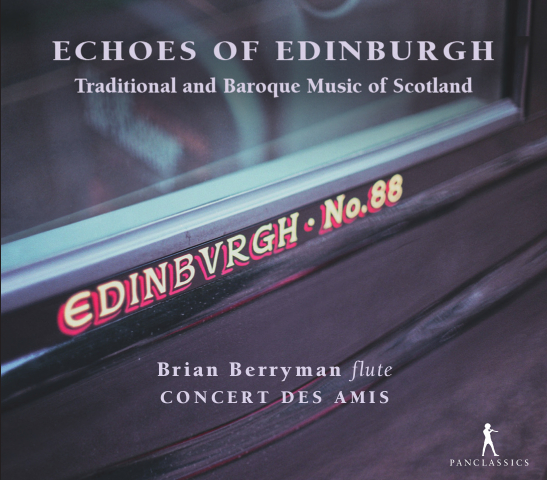
Echoes of Edinburgh
Echoes of Edinburgh
About the CD
It all started with a trip to Edinburgh. In the spring of 2022 I used a grant to re-visit that beautiful city with the official purpose of researching the overlap between traditional and baroque music in Scotland, and with the unofficial purpose of meeting as many trad players and playing as many sessions as possible. Thanks to the warm welcome from both the National Library of Scotland and also numerous music-filled pubs in town the trip was a resounding success, the fruits of which are embodied in this CD which combines musicians from seemingly disparate worlds into one production.
The presumed divide between „folk“ and „cultivated“ music becomes ever more porous and meaningless as you travel back through music history. Scotland‘s musical scene in the eighteenth century appears to make no clear distinction between the two: Their traditional musicians were often literate and held positions in local orchestras; violinists would happily moonlight with fiddle music played at the most prominent houses of the nobility. Manuscript collections of dance tunes would on occasion also include a sonata by Corelli or other composers, with no written commentary to suggest that this was an unusual or exotic inclusion. Music was divided more by function than by style, and composers of sonatas and composers of dance tunes moved in similar circles, enjoyed each other‘s company and in the case of Robert Mackintosh (c. 1745-1807), were one in the same person.
Content
1. Robert Mackintosh: “Lady Charlotte Set”: Lady Catherine Stewart Strathspey; Lady Charlotte Goold’s Reel; Miss Mary Garden of Troup’s Reel; Lady Charlotte Lennox Reel,
2. James Oswald: Airs for the Summer, Book 2: “The Flos Adonis”: Allegro con brio; Aria. amoroso; Giga. Vivace
3. James Scott Skinner: “Tullochgorum Set”: Rinn m'eudail mo mhealladh (“My love has deceived me”), Patrick MacDonald Collection, Variation (Brian Berryman); Tullochgorum with Variations
4. Francesco Barsanti: Overtura prima, Op. 4: (Overture), Allegro (Richmond Ball), Adagio; Andantino
5. Mackintosh: “Wat Ye Set”: Wat ye who met the streen (Slow); The Reel; Lord Chief Baron’s Favourite; Honourable Mrs. Maules’ Reel; Miss E. Macleod’s Reel
6. Barsanti: Overtura Seconda, Op. 4: Largo, Allegro, andante; Paesana. Allegro con spirito
7. Oswald: Airs for the Summer, Book 2: “The Thistle”: Pastorale. Andantino; Brilliante; Amoroso. Andante; Brilliante Da Capo
8. Mackintosh: “Wet & Cold Set”: Wet & Cold Are My People (Patrick MacDonald Collection); The Calledonian Hunt’s delight; Kiss the Lass you like best, The Lads of Dunce; Lady Mary Montague‘s Reel; There is no luck about the House
9. Barsanti: Overtura Sesta, Op. 4: Larghetto, Allegro moderato (To You fair Ladyes), Adagio; Menuet
10. Oswald: Airs for the Summer, Book 1: “The Batchelor’s Button”: Aria. Allegro moderato; Andante; Gavotta. Allegro
11. James Scott Skinner: “The Skinner Set”: The Haughs O’ Cromdale. Strathspey; Highland Whisky (strathspey); Talisker (strathspey), Angus Campbell. Reel; The De’il Amang the Tailors (variations: James Scott Skinner)
12. Oswald: Airs for the Autumn: “The Marvel of Peru”: Moderato. Scortese; Comic. Allegro ma non Presto; Musette. Allegro moderato
13. Barsanti: Ouvertura nona, Op. 4: Larghetto e staccato, Allegro (Countrey Bumpkin); Andantino e cantabile; Allegro
Purchase
€20 via Paypal:

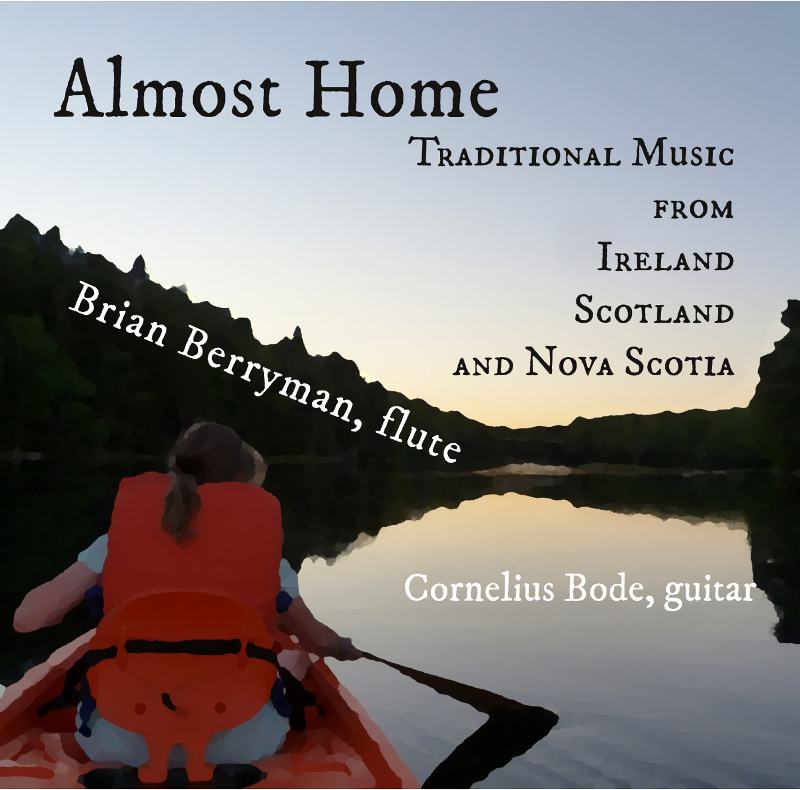
Almost Home
Almost Home: Traditional Music From Ireland, Scotland And Nova Scotia
What happens when a classically trained flutist from Nova Scotia, living in Germany, gets homesick? This CD is an attempt to answer that question. If you have ever arrived in a place for the first time and yet felt instantly at home, you will understand something of what playing traditional music means to me: Growing up in Nova Scotia means you're never far away from the sounds of Celtic music; after some years in Germany I decided to realize a long-held dream and began playing Irish flute. It became instantly clear to me that this was no mere hobby, nor was it just a sideline to the orchestral playing which forms the backbone of my career. After almost two decades of sessions and concerts I am only still dipping into the well; I have reconciled myself to having classical accents in my playing, just as I will never sound completely German despite years of trying! No matter: This traditional music welcomes those who approach it with admiration and respect, rewarding the player and listener alike. Traditional music players speak of their tunes as objects, heirlooms to be treasured and passed on as gifts. Not: "Where did you learn that?", but rather: "Who gave that one to you?". "I got this from my father" is a common reply. So when I'm playing a traditional tune, it is all mine for the moment, in that moment when I breathe life into it. Later I will pass it on to another player and it becomes his or hers, and so on. I like to hope that the Beethoven symphonies and Bach cantatas I play have gained something of this relationship; if music isn't personal why bother? And so even though I came from elsewhere I still have a strong sense of belonging; I'll never be a native, but neither am I a casual visitor. I feel welcomed; it is a great privilege and good fortune to be "almost home".
Purchase
https://store.cdbaby.com/cd/brianberryman?
Also available directly from me via PayPal for 14 € including shipping and PayPal fees
| CD Almost Home |

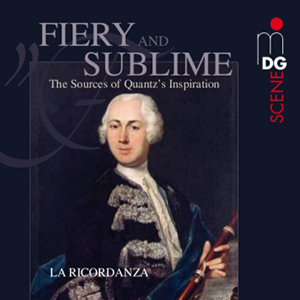
Fiery and Sublime
About the CD
"Consistent, fiery and sublime": These were the words used to describe the flute playing of Quantz in his obituary. Johann Joachim Quantz (1697-1773) was in many ways ahead of his time: In an era of constant wars and territorial feuds between rival duchies he was an apologist for an international musical style. In a time when musicians were seen as lackeys and servants he enjoyed a salary and status of which many of his contemporaries could only dream. Although he is known today primarily as "Frederick the Great's flute teacher", his musical education and development was more or less complete, when he took on his official duties in 1740 at the Berlin court (he was already over 40 years old). He gained his formative musical experiences at the court in Dresden and above all during his three-year journey from 1724-1727 through Italy, France, England and the Netherlands. This recording brings together two emblematic works of his with works of some of the composers that he met on his Grand Tour.
The furious and fiery Italian musical style was often contrasted with the pleasant and sentimental French music; Quantz felt that German music was particularly well positioned to profit from both styles, in order to develop its own "mixed taste". In the afterword to his Versuch he summed up his hopes for the future of music: "For a music, which is not native to only one province or one nation, but rather is accepted and enjoyed by many peoples, can only be seen as good when it is based on reason and healthy feelings."
Available directly from me for 18€ plus shipping, via PayPal. Please send me an email including the number of copies and your mailing address. Many thanks!
Crossing the Border: Traditional and Baroque Flute Music of the British IslesAbout the CD
The styles of baroque and traditional folk music often seem to be worlds apart, played by musicians who rarely cross the border into the other genre. Historically just the opposite situation was more common; the border between the two realms of baroque and folk music was a site of heavy traffic: Far from disdaining each other's style, violinist and fiddler often expressed mutual esteem for the other's music. Baroque composers made frequent use of folk melodies for their compositions; folk musicians in turn were influenced by the music of their colleagues at court. This CD selects some of the many baroque pieces which are variations on traditional melodies, interspersed with Irish and Scottish dance tunes from 18th-century sources or commonly heard in pub sessions today.
Content
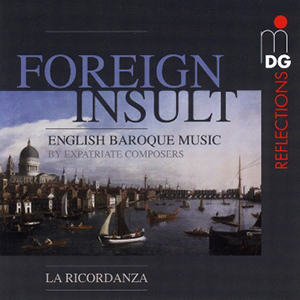
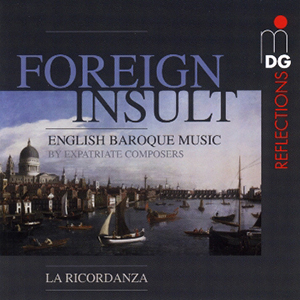
Foreign Insult
Available for direct purchase via PayPal. Please send me an email message with your address and order details.
| CD Foreign Insult plus shipping |
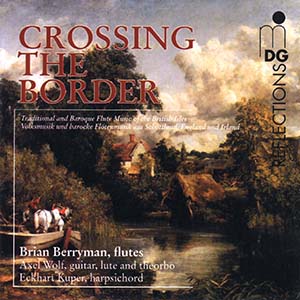
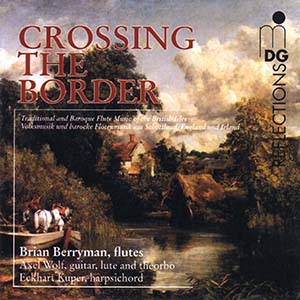
Crossing the Border
About the CD
The styles of baroque and traditional folk music often seem to be worlds apart, played by musicians who rarely cross the border into the other genre. Historically just the opposite situation was more common; the border between the two realms of baroque and folk music was a site of heavy traffic: Far from disdaining each other's style, violinist and fiddler often expressed mutual esteem for the other's music. Baroque composers made frequent use of folk melodies for their compositions; folk musicians in turn were influenced by the music of their colleagues at court. This CD selects some of the many baroque pieces which are variations on traditional melodies, interspersed with Irish and Scottish dance tunes from 18th-century sources or commonly heard in pub sessions today.
Content
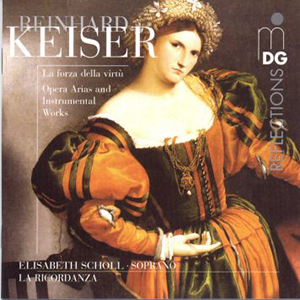
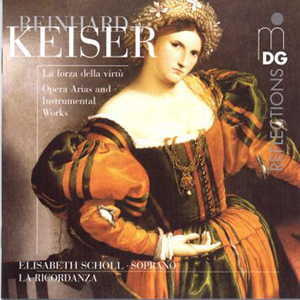
La forza della virtu
About the CD
Reinhard Keiser was born on the 9th of January 1674 in Teuchern near Weissenfels and died on the 12th of September 1739 in Hamburg. He was the most important composer for German-language opera in the high baroque period. His career as an opera composer began after he completed his education at the Leipziger Thomasschule, when in 1693 one his his operas was performed at the court theatre in Braunschweig. In 1697 his opera "Der geliebte Adonis" was staged in the Hamburg Theater am Gänsemarkt. Keiser remained a key figure for the Hamburg opera for over 40 years, serving as its artistic director from 1702 to 1707.
The selected arias on this CD provide an overview of Reinhard Keisers early work in Hamburg: 1697 Adonis, 1700 La forza della virtu, 1703 Claudius and 1704 Nebucadnezar. The violin concerto by Georg Philipp Telemann was inserted into a later production of Nebucadnezar in 1728.
The well known music theoretician Johann Mattheson, a friend of Keiser's, was an important voice among the Hamburg opera audience. He repeatedly expressed his admiration for Keiser the composer in his writings , maintaining that Keiser's works showed "all the passions of which the human heart is subject to".
Content
Reinhard Keiser
Die verdammte Staat-Sucht, oder der verführte Claudius (Scenes)
Sonata à 3 Nr. 1 (1725) for Traverso, Viola d'amore and Basso Continuo
Der gestürzte und wieder erhöhte Nebucadnezar, König zu Babylon (Scenes)
Georg Philipp Telemann
Concerto für 2 Violins, Viola, Violoncello and Basso Continuo
Der geliebte Adonis (Scenes)
La forza della virtù; oder, Die Macht der Tugend (Scenes)
Available directly from me, payment via PayPal. Please send me an email with your address and oder details. Many thanks!
CD La forza della virtu, plus shipping
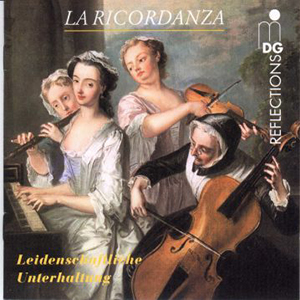
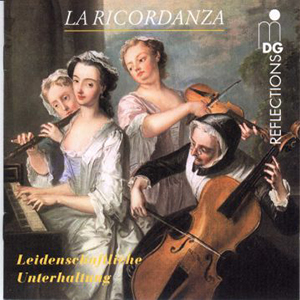
Leidenschaftliche Unterhaltung
About the CD
"...a well written concerto...resembles a passionate conversation between the soloist and the orchestra accompanying him; the soloist communicates his feelings to the ensemble; the ensemble applauds him with briefly inserted imitation, soon it confirms his expression; in the Allegro it tries to stoke the fire of his enthusiasm even further..."
Content
Available for direct purchase via PayPal. Please send me an e-mail with your address and order details.

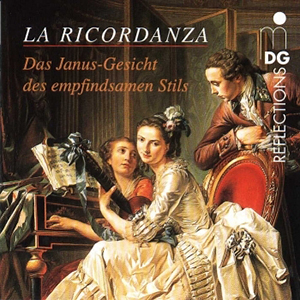
Das Janusgesicht des empfindsamen Stils
About the CD
In the second half of the eighteenth century music was Janus-faced: Like the ancient Roman god of doorways, beginnings and endings, music was focussed simultaneously on its baroque past and classical future. In attempting to depict stronger passions in music than was hitherdo deemed acceptable in public, composers strained the formal boundaries of music to their breaking point. Composers like Carl Philipp Emanuel Bach and Johann Gottlob Janitsch experimented with unresolved dissonances and speechlike phrasing, in an effort to expand the possibilities of musical expression within prevailing convention.
Content
Quartet in B Flat Major for Oboe, Violin, Viola and Violoncello
Available for direct purchase via PayPal. Please send me an e-mail with your address and order details.
YouTube
Clips from Brian's YouTube channel.
A set of traditional Scottish music beginning with "My Darling has Deceived Me" and finishing with J. Scott Skinner's "Tullochgorum Variations"
From my newest CD production "Echoes of Edinburgh", which brings together Scottish baroque and traditional music of the 18th and 19th centuries. I have assembled a set of tunes from Robert Mackintosh's 4th book of "New Strathspeys and Reels" and combined baroque instruments with guitar and bodhràn for some driving rhythms!
From my newest CD Echoes of Edinburgh, a gem of a sonata from one of Scotland's most celebrated and prolific composers, James Oswald (1710–1769).
My new CD Echoes of Edinburgh brings together Scottish baroque and traditional music. In his New Overtures Opus 4 Francesco Barsanti uses Scottish traditional music as the basis for the fugal movements, in this case "Richmond Ball"
There are further YouTube videos of CDs I have played on, posted by other YouTube members. Here are some links:
With La Ricordanza:
J. J. Quantz - Sonata for flute, recorder & continuo in C (QV 2: Anh. 3)
